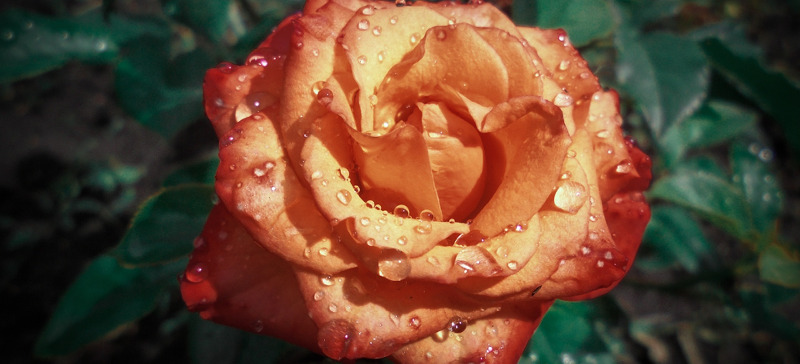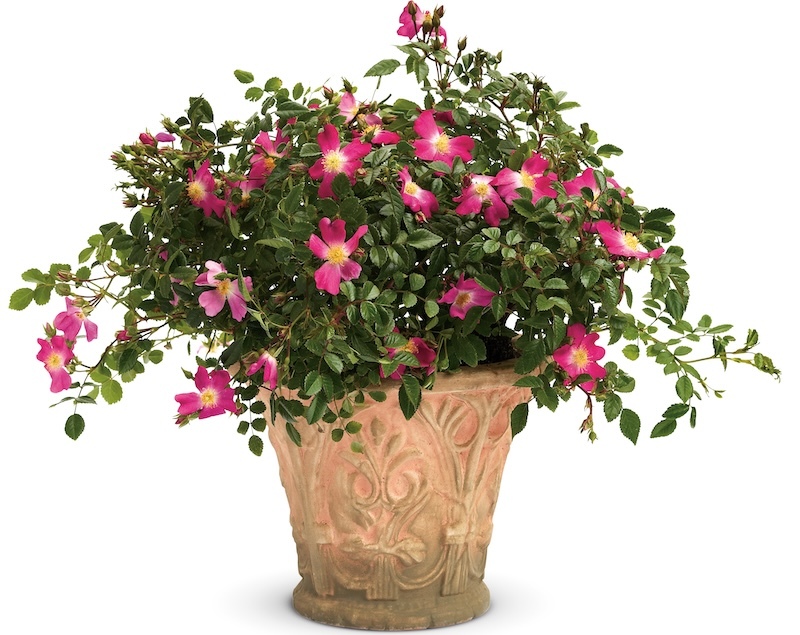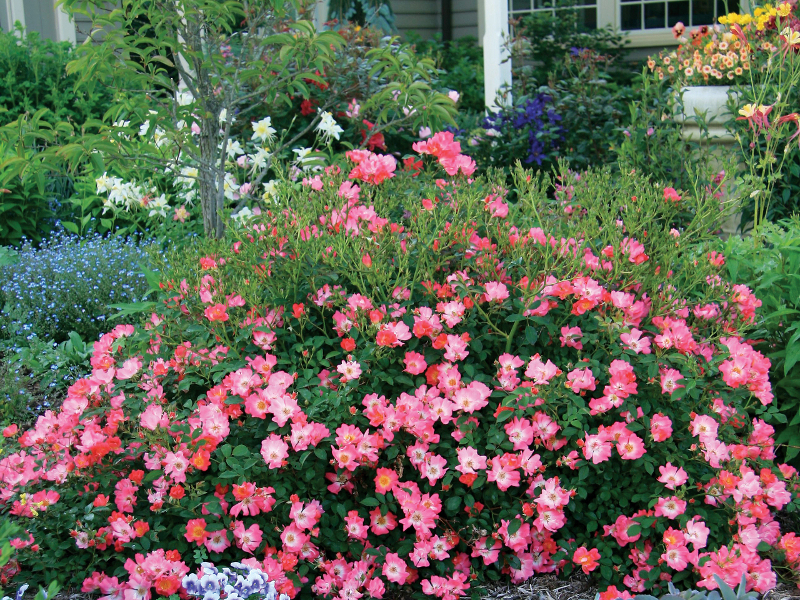According to fossil records, roses are one of the oldest cultivated flowers, beloved by Confucius in 500 B.C. as well as the ancient Egyptians and Romans. They likely originated in Central Asia and spread throughout the northern hemisphere.
Botanically they sit in the genus Rosa, from the family Rosaceae, which includes fruit trees like cherries, plums, and apples. They are grown for their bodacious beauty, often intoxicating fragrance, and even used medicinally (rose hips contain massive amounts of vitamin C). Sizes range from miniature roses at 18 inches tall, to rambling climbers, the largest known being a ‘Lady Banks’ rose in Tombstone, Arizona, covering at least 9,000 square feet.

Planting Roses
Choose a site with loamy well-drained soil that receives at least six hours of sun daily. The ideal soil pH is between 6 and 6.5. If planting bare-root, soak the root ball overnight before planting. Dig the hole at least 15 inches wide (wider than the root ball) and as deep as the roots.
If your rose is grafted, as many are, keep the knobby graft point at least an inch or two above ground to prevent encouraging the rootstock to grow. Top dress with compost, rose fertilizer, and two or more inches of mulch (again, not burying the stem or graft point). The best times to plant or move a rose are fall or early spring.
Watering Roses
It’s important to keep your roses regularly watered – particularly in the first few years in your garden as they become established. After that, they can be somewhat tolerant of dry spells, but consistent moisture is key to lush and healthy growth and bloom. Aim for two inches per week minimum, more in hot weather. Deep watering two or three times weekly is preferable for root development to frequent sprinkles. The soil needs to be well-drained; roses dislike “wet feet.”
Mulching will help retain moisture in the soil – keep the stems and the graft point (the knobby part – looks like a knee) clear. Watering at the soil level rather than the leaves will help lessen the chance of fungal diseases, so hand-watering, irrigation or soaker hoses are preferable to sprinklers.

Fertilizing Roses
Roses are heavy feeders, but you want to choose your food wisely. Compost and other natural soil amendments and fertilizers will promote the strongest leaf tissue that will better resist pests and diseases. Artificial fertilizers can promote lush but weak growth. For bare-root planting, use organic amendments at planting. Planting a containerized rose, you can add slow-release fertilizer in the hole.
Spraying with liquid kelp or seaweed can be protective against black spot and fungal diseases. For either, slow-release powdered or granular fertilizer formulated for roses can be applied once monthly from April through July. Fertilizing in late summer could encourage too much growth in the wet season.
Pruning Roses
The best time to do maintenance pruning is in early spring when leaf buds are just showing. Using bypass pruners (not anvil-style), cut away all dead or diseased wood. Clear away any fallen foliage. Prune established shrubs and tea-roses to 3-5 stems for best air circulation, cutting all others to the ground. Climbers can be as few as two stems.
You can remove 1/3 of the growth, cutting above a growing outward-facing bud. Don’t worry. Roses are super-resilient, so will usually bounce back from any goofs. In the growing season, deadhead repeat blooming varieties.
Caring For Roses in Pots
Give your rose a generous 10- to 15-gallon pot, with high-quality potting mix. If bare-root, only add organic amendments rather than fertilizers at planting. If containerized, plant with slow-release fertilizer. From April – July, add organic slow-release fertilizer, with an option of an organic liquid feed. Potted roses require more regular watering and fertilizing than in-ground plants.
Mulching helps retain moisture. Spraying with liquid kelp or seaweed early in the season can be protective against black spot and fungal diseases. Deadhead repeat-blooming varieties for increased bloom. Remove any imperfect foliage.

Winter Care for Roses
Avoid pruning until growth emerges in early spring – you don’t want to foster vulnerable growth before a frost. Top-dress with compost and any necessary soil amendments. Winter hardiness varies greatly in roses, depending in part on the variety and whether the rose has been grafted onto a (usually less hardy) root stock. For protection in USDA hardiness zones 7-13, apply 2-3 inches of mulch of organic material other than pine needles. In zones 1-6, consider hilling. Make a 12” x 12” mound around the stalk with extra soil, then mulch. Remove in spring.
Types of Roses
The Rosa genus offers over 300 species, thousands of varieties, almost every color, and comes in many shapes.
Cut Rose Care
If you plan on cutting some rose flowers for a bouquet or if you received a rose bouquet for a special occasion like Mother's Day, Valentine's Day or an anniversary, this guide will help ensure the flowers last as long as possible.
Drying and Preserving Roses
If you would like to make your roses last even longer, drying the flowers is a great option to maximize the beauty of the flowers.

Common Questions About Roses
What Are Own-Root vs. Bare-Root Roses?
Actually, own-root and bare-root have very little to do with each other. Own-root is in reference to how the plant is propagated (not grafted onto a host plant) and bare-root is referring to how the plant is presented, or sold (with the soil removed, usually bagged or boxed without a potting medium.)
Are There Shade-Tolerant Roses?
While roses are generally considered full sun plants and all of them need some sun to produce beautiful blooms, there are some varieties that can thrive with a bit of shade. Roses with softer colors will even look more vibrant against a shady backdrop! The Yellow Lady Banks Climbing Rose and the Red Knock Out Rose are some gorgeous roses that do well with shade!
Do Roses Like Full Sun Or Shade?
There are a few roses that will do well without a ton of sunlight, but generally speaking, roses need at least 6 to 8 hours of sunshine. The more sun, the more blooms!
Are Roses Invasive?
While roses are not considered to be an invasive species, they do have wide spreading roots that can sometimes throw suckers. These can be cut, trimmed, or mowed, if they're not desired.
What Are The Growth Rate For Rose?
Most roses are fast-growing and can reach their full, mature size after only a few years.
How To Make Roses Grow Bigger?
To encourage bigger roses, water consistently, keeps the soil moist but not wet, prune properly during the winter months (removing crossed, misshapen, weak, or dead branches) fertilize appropriately, and be sure to deadhead. You can also cut the bush back in the spring, to between 1.5 and 2 feet. Know that the farther you cut it back, the fewer blooms will produce, but the ones that do emerge will be larger than they would have been otherwise.
Have a question about Roses? Fill out the form below and we will try and get back to your question as soon as possible. We may even feature your question on this article to help other gardeners!
 |
Author Chris Link - Published 5-28-2021 |
